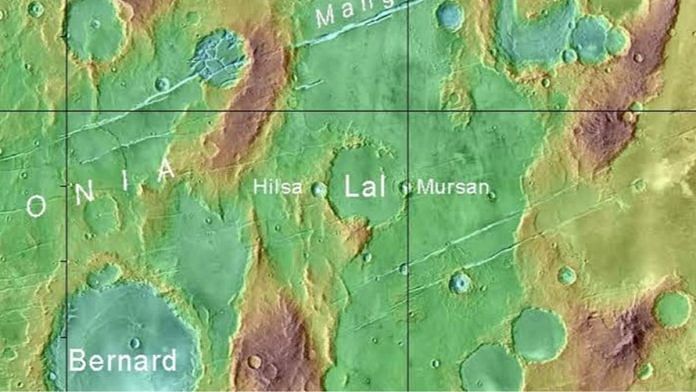New Delhi: Scientists from Ahmedabad’s Physical Research Laboratory (PRL) have discovered three new craters on Mars, which now bear names to honour the institute and two towns in Bihar and Uttar Pradesh.
They have been named Lal Crater — after Indian geophysicist and former PRL director Devendra Lal — and Mursan and Hilsa, after towns of the same names in Uttar Pradesh and Bihar, respectively.
These names were approved by the International Astronomical Union’s (IAU) Working Group for Planetary System Nomenclature (WGPSN) on 5 June.
The scientists said that all three craters are located in the Tharsis volcanic region of Mars, a vast volcanic plateau centred near the equator in the planet’s western hemisphere. With a width spanning 65 kms, Lal is the largest of the three new craters. The other two — both around 10 km wide — are located on the eastern and western sides of the rim of the Lal Crater.
“The entire area of Lal Crater, in the Tharsis volcanic region on Mars, is covered with lava. There is geophysical evidence of material other than lava in this crater, with a 45-metre thick sedimentary deposit in the subsurface of the crater, obtained using subsurface radar SHARAD (shallow radar),” a PRL spokesperson told ThePrint.
According to the researchers, this discovery provides compelling evidence that water moved large volumes of sediment into the crater now named Lal. The findings also confirm that Mars once had water, which flowed on its surface.
“The two small superimposed craters on either side of Lal Crater, named Mursan and Hilsa, provide the timeline for the infilling process of the Lal Crater and suggest that the infilling has been episodic,” the institute’s spokesperson said.
Also Read: IIT-Madras, NASA jointly study multidrug-resistant pathogens on International Space Station
Not the first Indian name for a Martian crater
This is not the first time Indian scientists have discovered and named a crater on the Red Planet. A number of the craters discovered by Indians have been named after Indian cities and towns.
For instance, the Poona, Lonar and Kakori craters have all been named after former and modern names of Indian towns and cities.
According to an international rule, craters less than 60 kms in diameter are named after towns with populations under 100,000. Once approved by the WGPSN, the names are considered official and can be used on maps and in publications.
The surface of Mars is full of craters of different sizes. Scientists also have different theories about what might have caused the planet’s surface to be so cratered.
National Aeronautics and Space Administration (NASA) scientists estimate that there are more than 43,000 impact craters on the surface of Mars with diameters greater than 5 kms. They also believe that most craters on the planet were formed by meteorite impacts early in its history, but some may be from more recent impacts.
The largest crater on Mars is believed to be the Hellas Planitia, which has a diameter of about 1,400 miles or over 2,250 kms. This enormous crater is located in the southern hemisphere and has a depth of over 11 kms beneath the average surface level of Mars. There have been speculations of it once being a large ocean.
Other large Martian craters include Argyre, Isidis, Schiaparelli and Lyot.
(Edited by Mannat Chugh)
Also Read: Gaganyaan to Shukrayaan — new govt to continue focus on R&D, quantum tech & big-ticket missions






